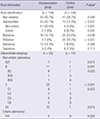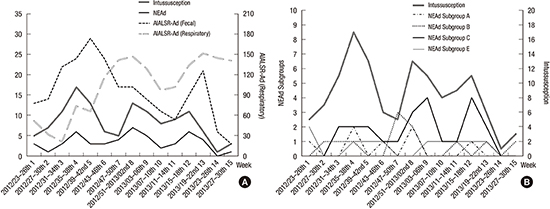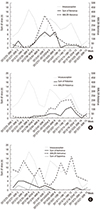1. Kennedy M, Liacouras CA. Intussusception. In : Kliegman RM, Stanton BF, St. Geme JW, Schor NF, editors. Nelson Textbook of Pediatrics. 20th ed. Philadelphia, PA: Elsevier;2016. p. 1812–1814.
2. Bell TM, Steyn JH. Viruses in lymph nodes of children with mesenteric adenitis and intussusception. BMJ. 1962; 2:700–702.
3. Kim JS, Lee SK, Ko DH, Hyun J, Kim HS, Song W, Kim HS. Associations of adenovirus genotypes in Korean acute gastroenteritis patients with respiratory symptoms and intussusception. Biomed Res Int. 2017; 2017:1602054.
4. Moore SW, Kirsten M, Müller EW, Numanoglu A, Chitnis M, Le Grange E, Banieghbal B, Hadley GP. Retrospective surveillance of intussusception in South Africa, 1998–2003. J Infect Dis. 2010; 202:Suppl. S156–S161.
5. Bruce J, Huh YS, Cooney DR, Karp MP, Allen JE, Jewett TC Jr. Intussusception: evolution of current management. J Pediatr Gastroenterol Nutr. 1987; 6:663–674.
6. Pang LC. Intussusception revisited: clinicopathologic analysis of 261 cases, with emphasis on pathogenesis. South Med J. 1989; 82:215–228.
7. Arbizu RA, Aljomah G, Kozielski R, Baker SS, Baker RD. Intussusception associated with adenovirus. J Pediatr Gastroenterol Nutr. 2014; 59:e41.
8. Murphy TV, Gargiullo PM, Massoudi MS, Nelson DB, Jumaan AO, Okoro CA, Zanardi LR, Setia S, Fair E, LeBaron CW, Rotavirus Intussusception Investigation Team, et al. Intussusception among infants given an oral rotavirus vaccine. N Engl J Med. 2001; 344:564–572.
9. El-Hodhod MA, Nassar MF, Ezz El-Arab S, Ahmed EF. Rotavirus fecal antigen retrieval in infantile intussusception. Eur J Clin Microbiol Infect Dis. 2008; 27:879–881.
10. Hsu HY, Kao CL, Huang LM, Ni YH, Lai HS, Lin FY, Chang MH. Viral etiology of intussusception in Taiwanese childhood. Pediatr Infect Dis J. 1998; 17:893–898.
11. Aminu M, Ameh EA, Geyer A, Esona MD, Taylor MB, Steele AD. Role of astrovirus in intussusception in Nigerian infants. J Trop Pediatr. 2009; 55:192–194.
12. Okimoto S, Hyodo S, Yamamoto M, Nakamura K, Kobayashi M. Association of viral isolates from stool samples with intussusception in children. Int J Infect Dis. 2011; 15:e641–e645.
13. Khalifa AB, Jebali A, Kedher M, Trabelsi A. Infectious etiology of acute idiopathic intussusception in children. Ann Biol Clin (Paris). 2013; 71:389–393.
14. Kaemmerer E, Tischendorf JJ, Steinau G, Wagner N, Gassler N. Ileocecal intussusception with histomorphological features of inflammatory neuropathy in adenovirus infection. Gastroenterol Res Pract. 2009; 2009:579501.
15. Chhabra P, Payne DC, Szilagyi PG, Edwards KM, Staat MA, Shirley SH, Wikswo M, Nix WA, Lu X, Parashar UD, et al. Etiology of viral gastroenteritis in children <5 years of age in the United States, 2008–2009. J Infect Dis. 2013; 208:790–800.
16. Jakab F, Péterfai J, Verebély T, Meleg E, Bányai K, Mitchell DK, Szûcs G. Human astrovirus infection associated with childhood intussusception. Pediatr Int. 2007; 49:103–105.
17. Lappalainen S, Ylitalo S, Arola A, Halkosalo A, Räsänen S, Vesikari T. Simultaneous presence of human herpesvirus 6 and adenovirus infections in intestinal intussusception of young children. Acta Paediatr. 2012; 101:663–670.
18. Bines JE, Liem NT, Justice FA, Son TN, Kirkwood CD, de Campo M, Barnett P, Bishop RF, Robins-Browne R, Carlin JB; Intussusception Study Group. Risk factors for intussusception in infants in Vietnam and Australia: adenovirus implicated, but not rotavirus. J Pediatr. 2006; 149:452–460.
19. Lee YW, Yang SI, Kim JM, Kim JY. Clinical features and role of viral isolates from stool samples of intussuception in children. Pediatr Gastroenterol Hepatol Nutr. 2013; 16:162–170.
22. Liu L, Qian Y, Zhang Y, Deng J, Jia L, Dong H. Adenoviruses associated with acute diarrhea in children in Beijing, China. PLoS One. 2014; 9:e88791.
23. Lee JI, Lee GC, Chung JY, Han TH, Lee YK, Kim MS, Lee CH. Detection and molecular characterization of adenoviruses in Korean children hospitalized with acute gastroenteritis. Microbiol Immunol. 2012; 56:523–528.
24. Chen SC, Wang JD, Hsu HY, Leong MM, Tok TS, Chin YY. Epidemiology of childhood intussusception and determinants of recurrence and operation: analysis of national health insurance data between 1998 and 2007 in Taiwan. Pediatr Neonatol. 2010; 51:285–291.
25. Takeuchi M, Osamura T, Yasunaga H, Horiguchi H, Hashimoto H, Matsuda S. Intussusception among Japanese children: an epidemiologic study using an administrative database. BMC Pediatr. 2012; 12:36.
26. Yang CM, Hsu HY, Tsao PN, Chang MH, Lin FY. Recurrence of intussusception in childhood. Acta Paediatr Taiwan. 2001; 42:158–161.
27. Wang GD, Liu SJ. Enema reduction of intussusception by hydrostatic pressure under ultrasound guidance: a report of 377 cases. J Pediatr Surg. 1988; 23:814–818.
28. Nicolas JC, Ingrand D, Fortier B, Bricout F. A one-year virological survey of acute intussusception in childhood. J Med Virol. 1982; 9:267–271.
29. Guarner J, de Leon-Bojorge B, Lopez-Corella E, Ferebee-Harris T, Gooding L, Garnett CT, Shieh WJ, Dawson J, Erdman D, Zaki SR. Intestinal intussusception associated with adenovirus infection in Mexican children. Am J Clin Pathol. 2003; 120:845–850.
30. Selvaraj G, Kirkwood C, Bines J, Buttery J. Molecular epidemiology of adenovirus isolates from patients diagnosed with intussusception in Melbourne, Australia. J Clin Microbiol. 2006; 44:3371–3373.
31. Ghebremedhin B. Human adenovirus: viral pathogen with increasing importance. Eur J Microbiol Immunol (Bp). 2014; 4:26–33.
32. Mandelboim M, Dror P, Azar R, Bromberg M, Mendelson E. Adenovirus infections in hospitalized patients in Israel: epidemiology and molecular characterization. J Clin Microbiol. 2011; 49:597–601.










 PDF
PDF ePub
ePub Citation
Citation Print
Print





 XML Download
XML Download